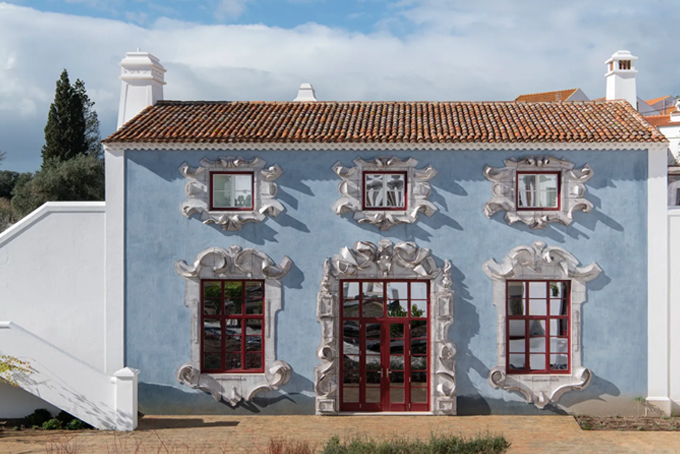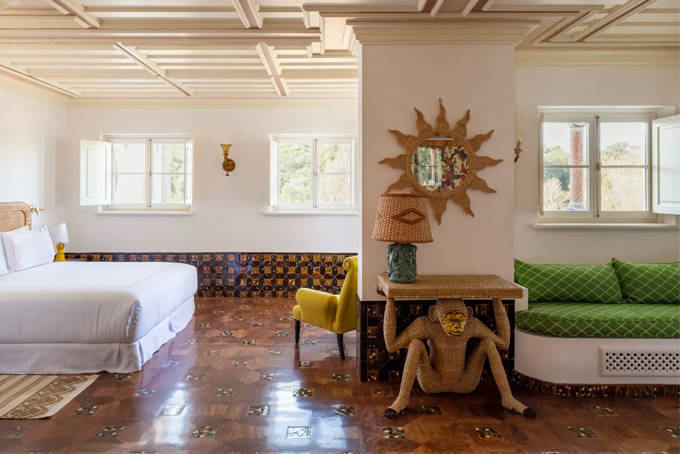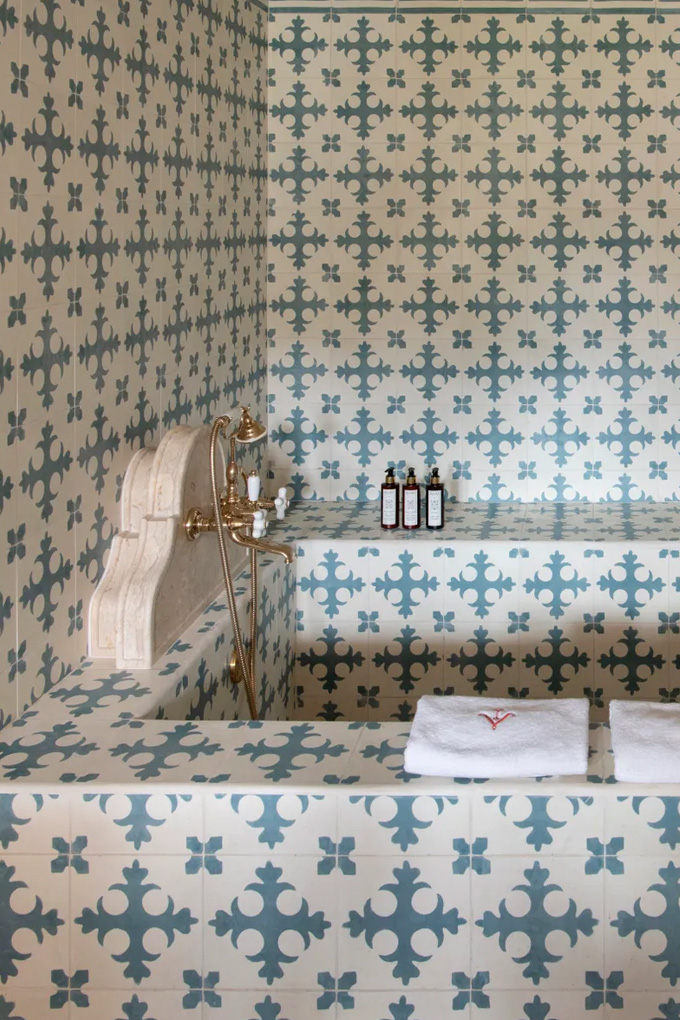The Portuguese village of Melides still feels like a well-kept secret. Despite being just an hour and a half south of Lisbon, and 20 minutes from its buzzy neighbour Comporta, the sleepy hamlet appears as if frozen in time from the 19th century. At its center is a cobblestoned square, where a whitewashed church spire looms over tiny family-run restaurants with outdoor terraces and rows of terracotta-roofed cottages with wrought-iron balconies. On a warm spring day, it’s entirely deserted—as is the beach, a golden, windswept slice of the Alentejo coast, that’s only a 10-minute drive away.
But change is afoot. Wind down the town’s meandering lanes, past orange trees and closed shop fronts, and you reach an imposing door carved out of dark wood. Behind it is a hive of activity, as the final touches are put on a property that is guaranteed to draw in a stylish new crowd and slowly transform this region into one of the hottest destinations in the country: Vermelho, the first hotel from the legendary shoemaker Christian Louboutin.

The designer, who’s owned homes in Lisbon and Comporta since the ’90s, stumbled upon Melides just over a decade ago. The story goes that he’d had an accident and was driving back from a local hospital when he noticed the picturesque town, bordered by lush forests and an expansive lagoon. He bought a fisherman’s house on its shores soon after and continues to return twice a year, both to work and unwind (his now-extended compound includes an atelier with panoramic views of the water). Louboutin’s hope, with Vermelho, is to share the raw natural beauty of his surroundings with visitors who might previously have bypassed this province in favour of Portugal’s largest cities or the Algarve—but he’s equally keen to preserve the tranquillity that brought him here in the first place.
To that end, his newly built boutique lodgings contain just 13 rooms and its exterior is designed, with the help of Louboutin’s friend, the Portuguese architect Madalena Caiado, to blend seamlessly into the environment with its powdery blue and white walls, gently sloped roofs and delicately carved chimneys. Once you go through the doors, though, it becomes decidedly more eclectic: while there are a wealth of distinctively Portuguese details, from the coffered ceilings to the stunning azulejo mural that faces the reception, the interiors also pay tribute to Louboutin’s French and Egyptian heritage, as well as the extensive travels that have inspired his countless collections.

There’s geometric flooring that’s reminiscent of the style found in Paris’s historic Hôtel de la Marine and, in the pocket-sized but intensely calming massage suite, the walls are layered with alabaster sourced from Luxor. In the extravagant communal sitting room, the glass tiles nod to the decadence of Rajasthani palaces, and downstairs, vintage Bollywood movie posters from the ’60s line the walls beside honey-coloured velvet banquettes and a fabulously ornate bar—a slab of green Indian marble overlaid with baroque silver paneling hammered in Seville by artisans more accustomed to constructing glittering church altars.
Turn a corner, and you might spot an ominous ceramic bust or a surreal wall dotted with ceramic, jewel-toned macaw heads. Meanwhile, the spectacular garden, dreamt up by Louboutin’s former partner, French landscape architect Louis Benech, surrounds a plunge pool, at the head of which reclines an elaborate rendering of Neptune by Giuseppe Ducrot. During my visit, the prolific Italian sculptor could often be found on the terrace, perfecting the similarly dramatic ceramic appliqués that adorn the building’s doors and windows. Unsurprisingly, there are flashes of Louboutin’s signature shade throughout, too: scarlet window frames, staircases, lacquered tiles in the bar, plush gilded stools and intricately woven Maison Gatti chairs in the restaurant, Xtian, all of which are as eye-catching and impactful as his iconic red soles. (Vermelho translates to “red” in Portuguese.)

If these public spaces skew maximalist, the rooms are more subdued and serene, though no less glamorous. Each is unique, even the smallest is remarkably spacious, and most are decorated with charming hand-painted tiles, primarily from Azulejos de Azeitão’s renowned workshop near Setúbal, where a team of 11 specialists worked for almost a year to create more than 7,000 individual pieces for the project. The delightful fusion of aesthetics continues here, with polished parquet floors, Moorish side tables, Murano glass-style wall lamps, antique Venetian mirrors, sea shell-shaped reading lights by the bed, and squishy floral armchairs that are the epitome of Italian nonna chic.
There’s no shortage of surprises either: your suite could contain a wardrobe with burnished gold doors, a framed Indian tapestry, a rattan monkey that forms the base of a table, or illuminated miniature art installations by Madrid-based creative Carlos Díaz De Bustamante. You could even encounter one of Louboutin’s personal treasures—a Spanish bargueño chest, for instance, or an embroidered Henri Samuel sofa—picked up at auction or while on holiday, and now finally unearthed from his archives.
“The designer, who’s owned homes in Lisbon and Comporta since the ’90s, stumbled upon Melides just over a decade ago”
Almost all of the rooms also have outdoor spaces where you can soak up the sun, whether they be suites with balconies overlooking the garden on the first floor, or ones on the ground floor with terraces that offer direct access to the pool. One of the former suites comes with a giant, opulently tiled outdoor bathtub, while some of the latter compensate with equally impressive bathrooms, covered floor to ceiling with more riotous tiling. They seem designed for your Instagram feed but, crucially, bathing at Vermelho feels luxurious too, thanks to fragrant Kama Ayurveda amenities, butter-soft Frette bathrobes, and heated floors for when the evenings become chilly.






